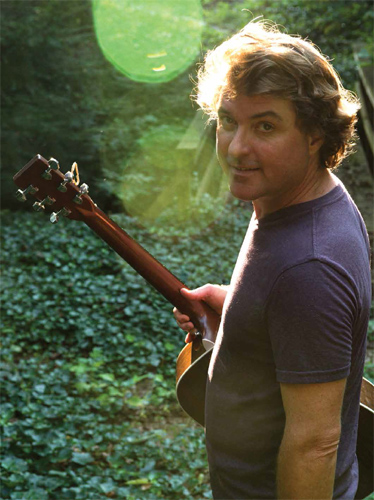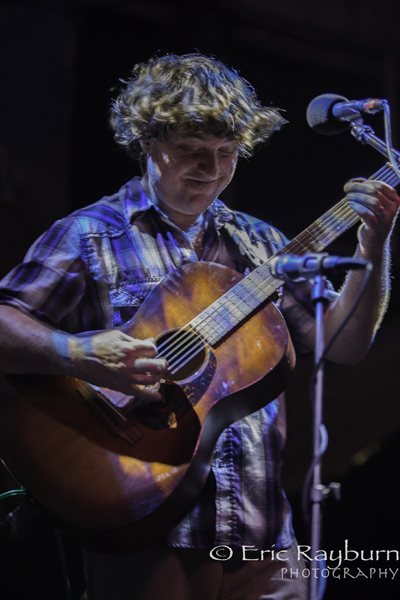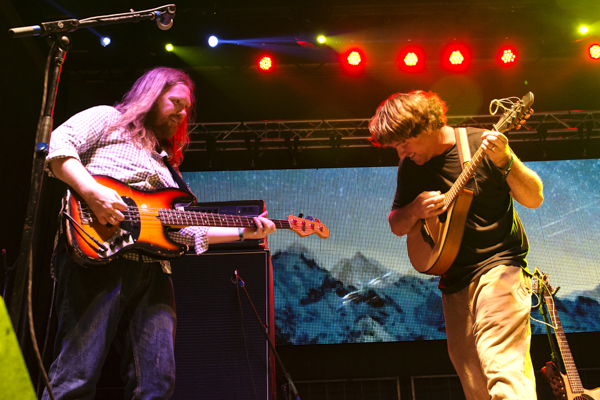Keller Williams: The Virginia Psychedelic Excursion

Prolific is as good a word as any to describe Keller Williams, though he would probably opt for something with fewer syllables. A veritable jack-of-all-trades, Williams has crisscrossed genres throughout the 20 monosyllabic-titled albums he’s released during a 21-year span— taking on everything from funk, bluegrass and electronica to children’s music and keyboard renditions of Grateful Dead classics. That’s all in addition to his onstage collaborations with The String Cheese Incident, Bob Weir, Phil Lesh, The Travelin’ McCourys and many others, and the one-man-band live shows that have earned him a well-deserved reputation as the jam scene’s leading Renaissance man.
“I think it’s just for my own mental health,” explains Williams from his home in Fredericksburg, Va. “I need to create things that are completely different from each other. It’s just the way I listen to music, the way I think and, I guess, the way I release records. A bluegrass record, a live funk record, a piano record—none of these things are remotely close to each other. It’s almost like apples, oranges and kumquats or whatever. It’s for my own personal headspace, to be proud of releasing things that don’t sound exactly like the thing I just released.”
What’s more impressive than the depth and breadth of Williams’ catalog is the fact that he’s managed to build it up without ever wearing out his welcome, always engaging his longtime fans from a different angle while winning over new ones in the process. His new album Vape continues that trend, though it’s his first release in almost six years that isn’t centered around an explicit musical theme.
“It started with a handful of songs that have been around for about five years and have never really found a home on a record,” says Williams. “Then another five or so came in that time frame as well. The idea going into it was upright bass, acoustic guitar and sick programmed drumbeats that’ll vibrate sternums and move pants just from the air of the subwoofer. I wanted to walk this line and create something similar to acoustic dance music. Of course, the end result didn’t really go full dance music or full electronica, but there are nods and certain elements of that type of music that crept their way in.”

This “acoustic dance music” is probably the closest thing there is to a term that encapsulates Williams’ sound on Vape, or a lot of his other releases for that matter. With its goofy lyrics—“She Rolls” tells the story of a cop-kissing car thief, “Donuts” is a love letter to a Virginia bakery and its circular pastries—and eclectic, electronically augmented grooves, the album is a bit of a return to form after years of putting out themed records. It’s also more in line with the style that first made Williams a live force to be reckoned with, providing ample opportunities for him to bend genres and get weird onstage.
“This whole concept of dance music—in the ‘80s and ‘90s, they called it techno music—has come a long way, but I think the origin of it starts with what the Irish considered ‘dance music,’” muses Williams. “I mean, a person standing on a stump playing a fiddle was dance music. There’s that double-time bluegrass thing, which you can kind of take into a minor key and add a bass line. But instead of a bass line, you make it a drumbeat—the mandolin could be the hi-hat—and it turns into house music.
“Even in my live shows, each song has an element of a backbeat and a vibe, whether it’s solo acoustic or not,” he continues. “So I’m always groovin’ and movin’ when I’m playing—whether it’s solo, with a band or with loops. It’s acoustic and it’s dancey. Hence, acoustic dance music.”
Williams kept this style in mind while recording Vape, but it wasn’t the only influence that he and his fellow musicians were under during their sessions at Wally Cleaver’s Recording in Fredericksburg. If the album’s title and its April 20 release date didn’t make the cannabis connection clear enough, then allow the man himself to elaborate.
“Marijuana is definitely a huge part of my style of music,” explains Williams. “It opens up my senses, it makes me want to be creative, it makes me want to play music. But the actual flower was not prominent in any of these sessions. However, the dense version of the flower—with high-pressure life blown through it—was very prominent, hence the name. That name also started as the acronym Va.P.E. which, of course, stands for Virginia Psychedelic Excursion.”
A lot has changed since Williams hit the scene with his debut album, Freek, back in 1994. For instance, recreational marijuana is now legal in four states and in the District of Columbia, while medical marijuana laws are on the books in 19 more. More personally, a lot has changed for Keller Williams. Whereas Freek was essentially a collection of tracks from his early years playing traditional solo acoustic tunes at tiny venues, subsequent albums saw Williams expand the scope of his sound as he brought on additional players, dove into bigger collaborations and showcased the pioneering live-looping techniques that would become an increasingly important part of his live show.
“I had been playing solo for a couple of years, and wanted to play with other people, but I couldn’t afford them. That’s where the looping kind of started,” recalls Williams. “There was a good decade or so of just playing restaurants, bars and coffee shops—typical solo, acoustic, guy-in-the-corner stuff. Then, The String Cheese Incident gave me the exposure I really needed at the time. My first gig opening for them was around 1996, and by 1999, I had done 150 gigs opening for them, along with a full album called Breathe [which was released in 2000]. That was when the looping thing started to creep in, and once that came, so did the bass. The turning point was once the bass found its way into my live stage loops. That was when I started to really move subwoofer air.”
After a year or two of looping difficulties—“I was using the wrong gear,” Williams notes—the technique finally clicked when bassist extraordinaire Victor Wooten introduced him to the Lexicon JamMan in 1998. His appropriately titled 2001 live album, Loop, which was recorded over the course of three shows in March of 2000, solidified the change in style, confidently showcasing a new sound that was piquing the interest of the greater jam scene.
As the profile of his one-man-jamband grew over the ensuing years, so did the number of artists who were interested in collaborating with him. A longtime fan of the Grateful Dead, Williams was as stoked as one might imagine when an opportunity to work with Bob Weir came his way.
“The first time I played with Bob Weir—probably back in 2002— was just over-the-top surreal,” recalls Williams. “When I used to go to their shows, I was always in the back on the lawn, or sometimes behind the stage if they used the whole coliseum. So to be in a small backstage room rehearsing with Bob Weir, that was just the most dreamlike, surreal thing ever at the time. It’s definitely gotten easier over the years to not be such a geeky fan around [Weir and Phil Lesh], but it’s still not quite normal because of the super unhealthy fascination I have with the Grateful Dead.”

Weir and Williams eventually co-penned a track called “Cadillac” for Williams’ 2007 album, Dream. That project, which took three years to make, also saw him team up with other greats, including Wooten, John Scofield, Béla Fleck, Charlie Hunter and Sanjay Mishra.
Dream was something of a milestone for Williams but, these days, collaborations with top-notch musicians are a dime a dozen for him. It’s a full-circle situation for a guy who learned the art of live-looping just to pay the bills. Whether he’s touring with his funk band More Than a Little, diving into bluegrass with The Keels and the McCourys, taking the stage with members of the Grateful Dead—he played different gigs with Lesh and Bill Kreutzmann this spring—or putting a string-band spin on the same music with a rotating cast of characters at his Grateful Grass shows, Williams rarely fails to leave a party in his wake.
“My world has become that of the weekend warrior,” explains Williams. “Three and a half days home, three and a half days gone. Come Monday, I’ll start diving into that weekend’s material and just live in it for a few days while I’m not in the drop-off and pick-up lines with my children at school. It’s really great, especially when there are a couple different projects in one weekend. It’s easy for me to shift gears musically like that—to have a funk gig one day, then a whole Travelin’ McCourys festival set the next day. I thrive on that. One solo gig, one funk gig and one bluegrass gig—that’s the perfect exciting weekend for me.”
At the end of the day, that excitement is what ties everything together for Williams and his fans. Bluegrass, funk, acoustic dance music—call it whatever you like. If it moves you, if it helps you have a good time, then Williams is probably down to partake.
“I always try and put myself in the place of the audience members and ask myself what would I want to hear if I was listening to music and drinking in a bar,” says Williams. “That’s where all the fun and the positivity comes from, just being an audience member onstage.”



















